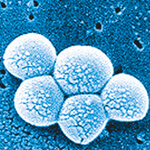
As parents prepare their children for classes, sports and other extra-curricular activities, there’s one thing they should beware this back-to-school season – bacteria.
One particular microorganism parents and students should be aware of is a staph bacterium called community-associated methicillin-resistant staphylococcus aureus (CA-MRSA). That’s a long name for a little bacterium that can cause a big infection.
“CA-MRSA is a complex bacterium that carries a particularly toxic protein,” said Jan Patterson, M.D., of the Health Science Center. “These bacteria contain genes that mediate antibiotic resistance, and a protein that makes them very aggressive and easily spread on the skin and underlying soft tissue,” she said. When left untreated, staph infections can poison the bloodstream or cause pneumonia.
Dr. Patterson is professor of medicine and pathology at the Health Science Center, director of hospital epidemiology for the University Health System and the South Texas Veterans Health Care System, and chief of medical services for the VA.
CA-MRSA has been reportedly spread in locker rooms, for example, by athletes who share dirty equipment, razors, or unwashed bath towels, or from physical contact with open wounds or turf burns on football fields.

Although cases are on the rise, there have been few substantial studies on how CA-MRSA is treated in surgical settings. Under the direction of Dan Dent, M.D., associate professor of surgery, and Dr. Patterson, Nabilla Porbandarwalla, second-year medical student, led the first epidemiological study of CA-MRSA in a surgical setting. What she discovered was disturbing. Of the more than 350 patients with CA-MRSA admitted to the emergency room at University Hospital, 71 percent did not respond to antibiotic therapy, which had been standard for these types of infections until this study was done.
“By the time we identified that CA-MRSA was responsible for these infections, some of the infections had become much more serious,” Porbandarwalla said.
One of Porbandarwalla’s and Dr. Patterson’s goals is to educate health care providers across the country regarding the proper diagnosis and treatment of CA-MRSA. Dr. Patterson recently met with representatives of the Texas Department of State Health Services to finalize health guidelines for the control and prevention of CA-MRSA.
“We plan to begin in Texas by providing educational outreach to primary care providers,” Dr. Patterson said.
Because a vaccine for CA-MRSA isn’t available to the general population, Dr. Patterson said awareness and education are the best defenses against contracting and spreading an infection.
Suspicious Symptoms
• A skin infection that may look like a spider bite, pimple or boil and can be red, swollen, painful, or have pus or other drainage.
• More serous infections may cause pneumonia, bloodstream infections or surgical wound infections.
How can I prevent a staph or MRSA skin infection?
• Wash hands and shower thoroughly with soap and water or use an alcohol-based sanitizer.
• Avoid contact with open wounds and keep cuts and scrapes clean and bandaged until healed.
• Avoid sharing personal items such as towels, razors or sports equipment.
• Establish routine cleaning schedules for shared equipment.
Source: U.S. Centers for Disease Control and Prevention
To view the Texas Department of State Health Services’ guidelines for the control and prevention of CA-MRSA, visit www.tdh.state.tx.us/ideas/antibiotic_resistance/overview/health_care/.

